Foraging the East Bay
Archived in 2022
Originally posted on 12 Mar 2011
I signed up for one of Forage SF’s Wild Food Walks. It was an excellent use both of my time and money. Our guide, Kevin Feinstein, wasn’t only knowledgable but was also very adept at teaching.
What follows is mostly to provide notes for myself but will hopefully prove useful to others who hope to forage nutritious veggies from their surroundings. I’ve enhanced Kevin’s notes from the walk with information from the following books:
- The Foraging Gourmet by Katie Letcher Lyle, ISBN-13: 9781558215290
- The Neighborhood Forager by Robert K. Henderson, ISBN-13: 9781552633069
- Edible and Useful Plants of California by Charlotte Bringle Clarke, ISBN-10: 0520032616
- Stalking the Wild Asparagus by Euell Gibbons, ISBN-13: 9780911469035
All photos in this post can be viewed in a larger format on my Wild Food Walk, East Bay set on Flickr.
First: caution is needed! While nutritious and tasty food is available almost everywhere you look, not all plants are created equal. Beware plants which grow in sub-par soil! Is it near a house (potential lead paint and danger of lead poisoning)? Is it near pressure-treated wood (potential arsenic poisoning)? Is it near a road or parking area (run-off of various toxins including lead)? Is it downhill from any of same (again, run-off dangers)? In general you should look for higher ground away from potential danger zones.
Also important: Foraging Is Illegal On Most Public Land! Some rangers and other organizations will turn a blind eye to it (especially if you harvest in a sustainable manner) but if you’re on public land you should assume that what you’re doing is against the law and you are liable for all the usual penalties if you are caught. You. Have. Been Warned.
Also also! Do Not Over-Harvest! If you find a good patch of something, do not harvest more than 1/3 of it (and 1/4 would be preferable). Take a little from this plant, a little from that, rather than wiping out entire plants. This will allow the patch not only to survive but also to thrive. Everyone’s a winner if you’re not a big greedy pig.
And now on to the interesting stuff… 🙂
Oxalis
 The first stop on the edible tour is Oxalis. Most homeowners in California know this plant as the bane of their yards and gardens. Once it takes root it’s very difficult to dispatch, even with extreme prejudice. I remember taking a weed-whacker to ours back in Albany and gaining little for my pains but a little breathing room before the plant took over the yard as well as a rash on my legs from the oxalic acid. Yeah, that was a good time. 😐
The first stop on the edible tour is Oxalis. Most homeowners in California know this plant as the bane of their yards and gardens. Once it takes root it’s very difficult to dispatch, even with extreme prejudice. I remember taking a weed-whacker to ours back in Albany and gaining little for my pains but a little breathing room before the plant took over the yard as well as a rash on my legs from the oxalic acid. Yeah, that was a good time. 😐
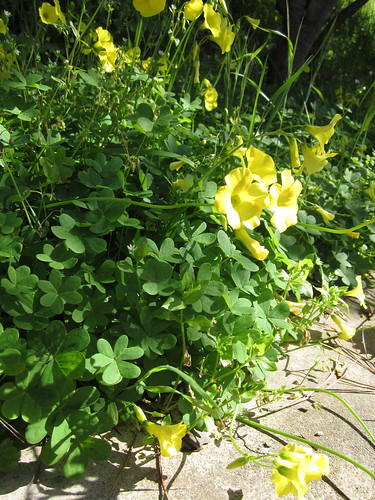 Still, these plants are edible. Children in California grow up knowing it as Sour Grass, thanks to the lemony, sour flavor. All parts of this plant are edible, though considering the oxalic level here you should take some care and not eat it in abundance unless you have a particular grudge against your kidneys. Too much oxalic acid can lead to kidney stones as well as other unpleasant effects. That said, it’s not such a bad thing in small quantities. Spinach and rhubarb are rich in oxalic acid, among other common vegetables.
Still, these plants are edible. Children in California grow up knowing it as Sour Grass, thanks to the lemony, sour flavor. All parts of this plant are edible, though considering the oxalic level here you should take some care and not eat it in abundance unless you have a particular grudge against your kidneys. Too much oxalic acid can lead to kidney stones as well as other unpleasant effects. That said, it’s not such a bad thing in small quantities. Spinach and rhubarb are rich in oxalic acid, among other common vegetables.
As I said earlier, all parts of this plant are edible. You can eat them raw (likely preferred) or cooked. The roots, while edible, are not particularly palatable so you may want to leave them where they are…unless you want to rid your yard of this potentially invasive pest.
Grass
 Next up: grass. Yes, grass. Plain ol’ decoratin’ your yard grass. Ever have http://en.wikipedia.org/wiki/Wheatgrass"wheatgrass</a> juice? Yeah, just grass. Wheat, barley, oats… These are grasses, people. The grass in the photo is unidentified but Kevin noted that it’s not wild oats because the seeds aren’t cascading from the top as you’d expect from a “grain grass.” Regardless, all grasses can be treated the same from a hungry-human point of view. Unlike ruminants we can’t digest the fibers of a grass but we can get nutrients from them (and tasty goodness, besides) by chewing on them and sucking out the juice. Oh, don’t look at me like that. Remember the wheatgrass juice? Remember that? Same thing but without the mechanical extractor and exorbitant price tag. Just roll up a stalk of grass, put it in the back of your mouth and chew on it for a bit, sucking out the juice that’s generated.
Next up: grass. Yes, grass. Plain ol’ decoratin’ your yard grass. Ever have http://en.wikipedia.org/wiki/Wheatgrass"wheatgrass</a> juice? Yeah, just grass. Wheat, barley, oats… These are grasses, people. The grass in the photo is unidentified but Kevin noted that it’s not wild oats because the seeds aren’t cascading from the top as you’d expect from a “grain grass.” Regardless, all grasses can be treated the same from a hungry-human point of view. Unlike ruminants we can’t digest the fibers of a grass but we can get nutrients from them (and tasty goodness, besides) by chewing on them and sucking out the juice. Oh, don’t look at me like that. Remember the wheatgrass juice? Remember that? Same thing but without the mechanical extractor and exorbitant price tag. Just roll up a stalk of grass, put it in the back of your mouth and chew on it for a bit, sucking out the juice that’s generated.
In California the wild oat is a very common—and very tasty—grass. If you find some in the correct season you can harvest its grains for the best bowl of oatmeal you’ll ever have. If the grains aren’t ripe yet you can still eat them (they’ll still taste like oats).
A note about grasses: please don’t mistake them for aliums. While no grasses are poisonous there are a number of aliums which are. The two are relatively easy to distinguish, once you learn a little about each. For instance, aliums will be very juicy and herbaceous whereas grasses will typically be more fibrous and tough. There’s an edible alium later on in this article, FYI…
Chickweed
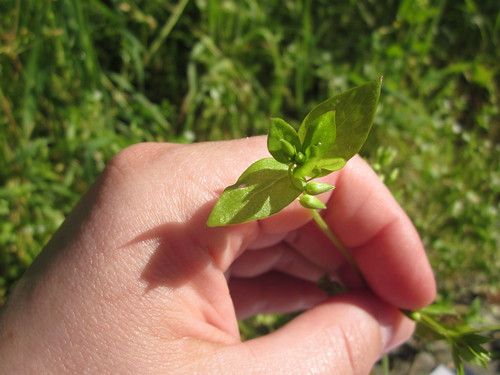 Chickweed is abundant throughout California. It likes cool, shady places of which there is no lack in our many forests and yards. It’s a slight, spindly sort of plant with tiny white flowers, the buds of which droop before they bloom. Chickweed will have a row of tiny hairs growing up just one side of the stalk. The entire plant is edible and, might I say, quite delicious. It may be eaten either raw or cooked but from what I could tell in the field I’d suggest it raw. Cooked it would taste like you’d boiled a lettuce. Raw it’s fresh and green and full of life and just darn tasty. When we tasted it many of us agreed that it tastes like corn silk smells which, in my case, is a very good thing.
Chickweed is abundant throughout California. It likes cool, shady places of which there is no lack in our many forests and yards. It’s a slight, spindly sort of plant with tiny white flowers, the buds of which droop before they bloom. Chickweed will have a row of tiny hairs growing up just one side of the stalk. The entire plant is edible and, might I say, quite delicious. It may be eaten either raw or cooked but from what I could tell in the field I’d suggest it raw. Cooked it would taste like you’d boiled a lettuce. Raw it’s fresh and green and full of life and just darn tasty. When we tasted it many of us agreed that it tastes like corn silk smells which, in my case, is a very good thing.
Chickweed used to be very highly valued for its nutritious and medicinal properties. Now, alas, it is often seen as a weed. However the same can be said of many of the plants in this article, so… Yeah, your mileage may vary.
Beware the chickweed impostor! There are look-alikes which have pink/orange flowers and no hairs on the stalk. You probably won’t die from eating them but you surely won’t enjoy it nearly as much as if you’d eaten real chickweed.
Miner’s Lettuce
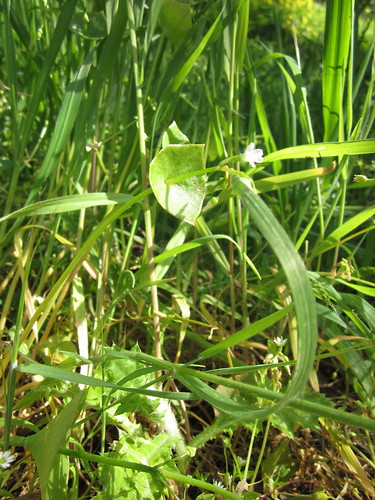 Miner’s lettuce! If there’s an easier to identify edible I don’t know what it is! There is nothing which looks quite like miner’s lettuce, with its distinctive “white or pink flower springing from a disc of green.” While the young version differs in appearance slightly it is still quite easy to spot. This plant, like the chickweed, enjoys cool, shady locations. So much so, in fact, that the two plants are almost always found in the same area.
Miner’s lettuce! If there’s an easier to identify edible I don’t know what it is! There is nothing which looks quite like miner’s lettuce, with its distinctive “white or pink flower springing from a disc of green.” While the young version differs in appearance slightly it is still quite easy to spot. This plant, like the chickweed, enjoys cool, shady locations. So much so, in fact, that the two plants are almost always found in the same area.
While, yes, you can cook miner’s lettuce it almost seems a shame. The flavor and consistency of this herb puts to shame the freshest and most succulent lettuce you’ve ever had in a restaurant salad. And, not coincidentally, salad is the use to which I suggest you put miner’s lettuce.
Nota bene: even if you do not enjoy eating the stem of the miner’s lettuce (more fool, you), please pick the entire thing down to the base. If you leave just the stem it will not grow more leaves and will serve just to sap the strength of the plant as a whole. Also, be careful when you harvest from the plant. The roots are very shallow and you could easily pull the entire thing from the ground. Instead, pinch the stems you want from the base, leaving the roots intact and in place.
Thistle
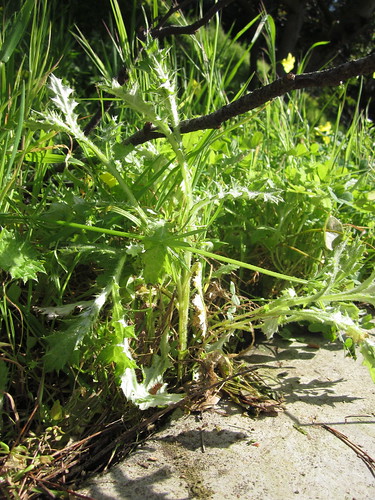 Every piece of the thistle is a tasty—if difficult—treat. As plants go this one ranks fairly high on the nutrition scale but, as you can see, it’s not particularly hospitable and takes some doing in order to enjoy it. While all bits are edible the stem is the piece which is most accessible to the wayward chef. The spikes which cover the plant must be removed before eating and this proves far too tedious a task for the leaves. For the stem, however, all you need do is peel it. You’ll still need to wear gloves, though, as these spines are pretty brutal. You may eat the thistle either raw or cooked. Its recommended that if you want to eat the roots you do so cooked and boil the dickens out of them as they’re unpalatably fibrous else.
Every piece of the thistle is a tasty—if difficult—treat. As plants go this one ranks fairly high on the nutrition scale but, as you can see, it’s not particularly hospitable and takes some doing in order to enjoy it. While all bits are edible the stem is the piece which is most accessible to the wayward chef. The spikes which cover the plant must be removed before eating and this proves far too tedious a task for the leaves. For the stem, however, all you need do is peel it. You’ll still need to wear gloves, though, as these spines are pretty brutal. You may eat the thistle either raw or cooked. Its recommended that if you want to eat the roots you do so cooked and boil the dickens out of them as they’re unpalatably fibrous else.
Thistles are, by the by, in the same family as artichokes and cardoons. Young thistle flowers can be eaten like tiny little artichokes, which is kind of a lovely thought for those of us who like that sort of thing.
Pines
Yes, pines. The sort you likely have growing in your yard. The very ones. Did you know you can eat from those? No? Ever hear of pinenuts? Where do you think those come from, anyway? That’s right: pine trees. Pinecones, to be specific, which means you’ll likely end up taking a squirrel to the mat in order to get your hands on some but it’ll be well worth the effort. If the pinenuts are large enough to eat then they’re large enough to be tasty. The gray pine is the one which creates the massive “bombs away!” sized pinecones. These, naturally, also generate the largest and most desirable pinenuts.
Pinenuts aren’t the only culinary use for the pine, oh no. How about pine bark? Not the exterior bark but the white, tender bark beneath? It’s full of starch and sugars and nutrients. Really, you could almost live off this stuff. However to get to it you kind of have to cause irreparable damage to a pine tree so please don’t rampage about slashing pines to get to the inner bark. Instead look for harvest opportunities like tree-fellings.
But wait, there’s more! In the early spring you can harvest the most prized pine portion of all: pine pollen. There are two gender of pinecones: female and male. The females are the ones you usually think of when someone says pinecones: large, woody, etc. The males are the small catkin-type cones which fall from the trees in the spring and litter your sidewalk. If you can get to these before they fall (or before the rain dislodges the pollen), you can harvest a very tasty and nutritious food. Place a plastic bag over the branch and then whack it a bit to knock the pollen from the cones. Alternatively you can collect the cones (delicately) and sieve the pollen from them. The end result is a pollen which is a complete protein and which contains a natural form of testosterone. Some say that this helps to balance the hormones and bring everything in the body back into more equilibrium. Kevin states that adding pine pollen to his morning smoothie has given him far more energy than he had before. I’ve no experience with the stuff and cannot speak to any claims. All I know is that it sounds very tasty.
California Bay

Aside from the typical usage of steeping leaves in stews and the like you can also eat the very young buds of the bay flower. The flowers themselves are also edible but rather strongly flavored so you’d do well to stick with the buds instead.
Too late to get to the buds? By all means let the flowers ripen and you’ll be rewarded with Bay Nuts. A bay nut is purple-black on the outside and relatively small in size (about the diameter of a quarter). As a relative of an avocado, it’s a rare thing to find one that’s entirely ripe. Either it’ll be half ripe and half rotten or half ripe and half unripe or… You get the picture. However if you find some which are ripe all the way through you’ll be rewarded with fruit which tastes like avocado with a hint of bay.
Better than the fruit? The seed itself. This is the ‘nut’ of the Bay Nut and it can be harvested whether the entire fruit is ripe or not. In fact the easiest way to gather them is often from the ground beneath the tree, picking up the dropped and rotting fruits. This usually happens in November. Please wear gloves when you do this as the bay oils can be a bit harsh to some peoples’ skins. Remove the seeds/nuts from the fruit and then store them until you’re ready to use them. They’ll keep for rather a long time. Once you’re ready, remove the seeds from the shells (an easy task) and then roast them. The end result will taste a lot like coffee or chocolate. The fat in the seed actually behaves a lot like the fat in the cocoa bean. You can even grind up the roasted seeds and use them as a coffee substitute. They contain a stimulant very similar to caffeine.
Wild Onion Lily
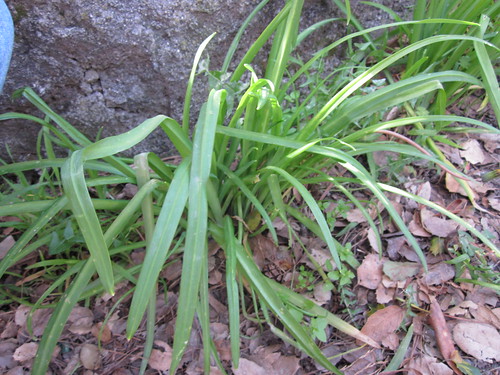 Onions, garlic, shallots, lilies… These are all aliums. While many aliums are edible and awesome (mmm…garlic…) some will make you dead sick. How can you tell the difference? Well, pick some. Now smell. Do you smell onion or garlic? No? Put it down and slowly back away. If you do smell onion or garlic then you’re set. Every part of that plant is edible and delicious. Flowers, stems, leaves, bulbs… Everything will taste of onions or garlic and thereby enhance your other savory foods.
Onions, garlic, shallots, lilies… These are all aliums. While many aliums are edible and awesome (mmm…garlic…) some will make you dead sick. How can you tell the difference? Well, pick some. Now smell. Do you smell onion or garlic? No? Put it down and slowly back away. If you do smell onion or garlic then you’re set. Every part of that plant is edible and delicious. Flowers, stems, leaves, bulbs… Everything will taste of onions or garlic and thereby enhance your other savory foods.
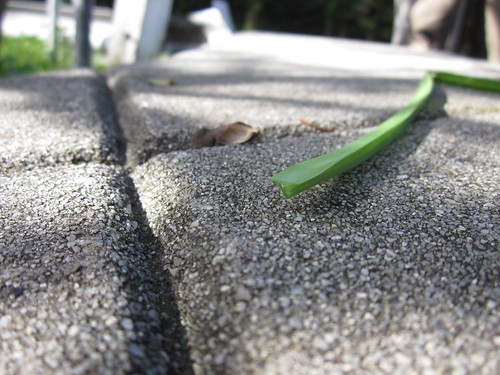 As mentioned earlier, you can differentiate aliums from grasses because, well, aliums are juicy. When you pick one you’ll know what I mean by that. In the case of the wild onion lily you’ll also note the shape of the stem. It’s rather triangular, isn’t it? Between that and the very oniony smell there’s no doubt that this is an edible plant. We didn’t taste the specimen here at it was growing in a crack in the pavement. While it shows that it’s undoubtedly a hardy plant it’s also likely one tainted by runoff and car-related pollution.
As mentioned earlier, you can differentiate aliums from grasses because, well, aliums are juicy. When you pick one you’ll know what I mean by that. In the case of the wild onion lily you’ll also note the shape of the stem. It’s rather triangular, isn’t it? Between that and the very oniony smell there’s no doubt that this is an edible plant. We didn’t taste the specimen here at it was growing in a crack in the pavement. While it shows that it’s undoubtedly a hardy plant it’s also likely one tainted by runoff and car-related pollution.
 These are wild onion lily flowers. As mentioned earlier, they’re just as edible as the rest of the plant. The same can be said for all edible aliums. In fact, you can sometimes find fried alium flowers in higher-end restaurants in the Bay Area. Rather than spending a fortune on them in the restaurant you can make them yourself by locating some edible alium flowers (garlic flowers work very well for this), dipping them in a tempura batter and then dropping them into a deep fry until golden and crispy. The hardest part about this is having a deep fry setup at the ready (oil + dutch oven and you’re set; yeah, it’s that easy). The first time you try this you’ll wonder how you’d lived so long without it.
These are wild onion lily flowers. As mentioned earlier, they’re just as edible as the rest of the plant. The same can be said for all edible aliums. In fact, you can sometimes find fried alium flowers in higher-end restaurants in the Bay Area. Rather than spending a fortune on them in the restaurant you can make them yourself by locating some edible alium flowers (garlic flowers work very well for this), dipping them in a tempura batter and then dropping them into a deep fry until golden and crispy. The hardest part about this is having a deep fry setup at the ready (oil + dutch oven and you’re set; yeah, it’s that easy). The first time you try this you’ll wonder how you’d lived so long without it.
Cow Parsnip
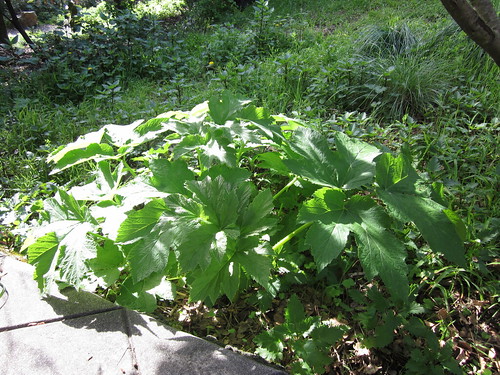 I don’t think this one was on the syllabus for the afternoon but as it happened to be there Kevin told us about it. This is, as the name implies, a member of the carrot/parsnip family. You can dig up the root if you wish but it’s just going to be more strongly flavored than the leaves (which are slightly toxic) and stem. Having tasted the stem I can tell you: you don’t wish to try the root. While the stem did smell very reminiscent of orange blossom water it did not taste that way. My summary of its flavor is: vile. If you simply must eat this thing please do peel the stems first. The hairs on the exterior can irritate the skin and the fibrous exterior is generally unpleasant to eat.
I don’t think this one was on the syllabus for the afternoon but as it happened to be there Kevin told us about it. This is, as the name implies, a member of the carrot/parsnip family. You can dig up the root if you wish but it’s just going to be more strongly flavored than the leaves (which are slightly toxic) and stem. Having tasted the stem I can tell you: you don’t wish to try the root. While the stem did smell very reminiscent of orange blossom water it did not taste that way. My summary of its flavor is: vile. If you simply must eat this thing please do peel the stems first. The hairs on the exterior can irritate the skin and the fibrous exterior is generally unpleasant to eat.
Calendula
 This beautiful orange flower is a calendula. As plants go this one is rather a big player in the natural remedy circles, being known for its various anti-microbial properties. That aside, it’s also delicious. The flower petals are often included in the “edible flower” packs you see in the farmer’s market. The rest of the plant is also edible. The flower buds are particularly tasty, though you’ll find that they’re rather sticky at that stage in their development.
This beautiful orange flower is a calendula. As plants go this one is rather a big player in the natural remedy circles, being known for its various anti-microbial properties. That aside, it’s also delicious. The flower petals are often included in the “edible flower” packs you see in the farmer’s market. The rest of the plant is also edible. The flower buds are particularly tasty, though you’ll find that they’re rather sticky at that stage in their development.
Among their other reputed properties, calendula are believed to dispel evil and used to be planted around hospitals for that purpose. You can use their petals in recipes in place of saffron (for color, if not flavor).
Wild Lettuce
 This? Not edible. I know, I know… You’re thinking, “But! It’s a lettuce! Lettuces are good!” And you’d be correct…of modern lettuces. But what we have here is the precursor of all lettuces. It’s edible but only inasmuch as it won’t kill you. This plant is incredibly bitter, particularly the milky secretion you’ll find when you pick a leaf. This is not a plant you’d like to find in your salad or on your sandwich.
This? Not edible. I know, I know… You’re thinking, “But! It’s a lettuce! Lettuces are good!” And you’d be correct…of modern lettuces. But what we have here is the precursor of all lettuces. It’s edible but only inasmuch as it won’t kill you. This plant is incredibly bitter, particularly the milky secretion you’ll find when you pick a leaf. This is not a plant you’d like to find in your salad or on your sandwich.
That said, it is an herb you’d want around if you’re feeling poorly. Wild lettuce is a very medicinal plant. Until the advent of opiates the sap of wild lettuce was used to dull pain. Its properties are so strong that it was used to reduce the effects of opium addiction. It is still used as a sedative in some cultures.
Sow Thistle and Dandelion
 These two plants are equally edible, which is to say “entirely.” They may become bitter as they age but in general you can count on a lot of nutrition should you eat either. The sow thistle is on the left in this photo, the dandelion on the right. Aside from the obvious leaf differences, dandelions can be distinguished from the single flower which comes up from the basal floret whereas the sow thistle will have multiple flowers.
These two plants are equally edible, which is to say “entirely.” They may become bitter as they age but in general you can count on a lot of nutrition should you eat either. The sow thistle is on the left in this photo, the dandelion on the right. Aside from the obvious leaf differences, dandelions can be distinguished from the single flower which comes up from the basal floret whereas the sow thistle will have multiple flowers.
The sow thistle is historically known to have similar (if weaker) sedative properties as the wild lettuce.
Wild Fennel
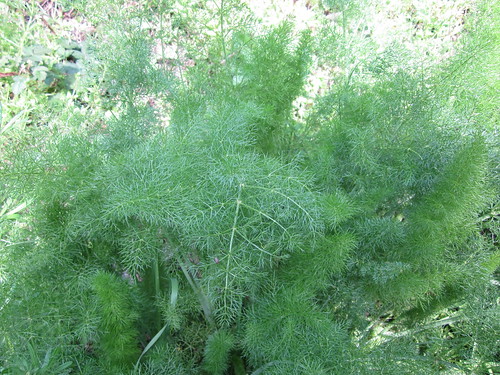 If you live in Northern California then you already know fennel. This is the fragrant and feathery weed which overruns every road side and vacant lot. Unlike the fennel you’ll find in the supermarket this variety has little in the line of bulb at the base of the stalk. Instead its goodness mostly lies in its fronds and its pollen and seeds.
If you live in Northern California then you already know fennel. This is the fragrant and feathery weed which overruns every road side and vacant lot. Unlike the fennel you’ll find in the supermarket this variety has little in the line of bulb at the base of the stalk. Instead its goodness mostly lies in its fronds and its pollen and seeds.
Beware any similar herb in the wild! If the plant you’re looking at doesn’t smell like fennel/licorice when you bruise it then Do. Not. Eat. It. Or do eat it, but only if you don’t mind a final meal of poison hemlock.
Dock
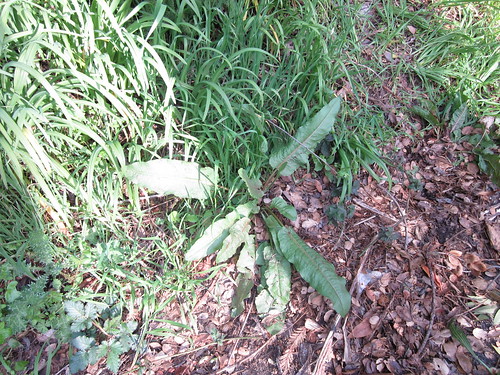 There are several different kinds of dock but they’re all equally edible. You’ll want to get young leaves (note how it’s curled in on itself; this is called a “scroll”). All dock leaves will be somewhat bitter but the young ones will be considerably less so. You also may find that the young leaves are a bit, uh, slimy when you go to pick them. This may difficult to harvest them with your hands only so come prepared to cut them from the plant.
There are several different kinds of dock but they’re all equally edible. You’ll want to get young leaves (note how it’s curled in on itself; this is called a “scroll”). All dock leaves will be somewhat bitter but the young ones will be considerably less so. You also may find that the young leaves are a bit, uh, slimy when you go to pick them. This may difficult to harvest them with your hands only so come prepared to cut them from the plant.
The root of a dock plant is considered to be very medicinal though, as you probably expect, very bitter and rather unpalatable.
The dock is related to buckwheat (not to the burdock). As such its seeds can be used in a similar way. The hull of the seed is very thick, taking up a large proportion of the seed size and difficult to remove. Instead of removing it people who use them commonly just grind the entire thing—seed and all—into flour.
Horsetails
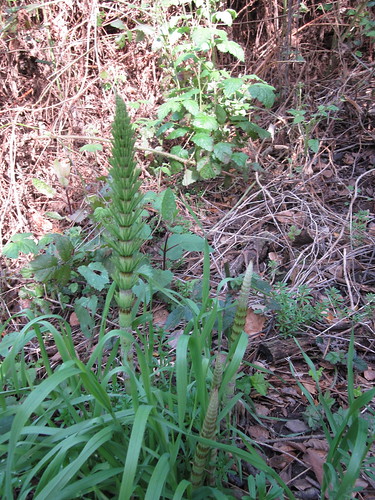 Horsetails are among the oldest of plants. You can find traces of them back to the dawn of the fossil record and they continue today in much the same form. They are incredibly high in silicates. While some people will cook and eat the young specimens most people find this too gritty for their taste and prefer to take their horsetails in tea form. Regardless, it’s best to choose the young specimens before they get too old and tough. Older specimens of horsetails are so tough and abrasive that for thousands of years people have used them to scour pots, pans and the like. Some of them will grow to several feet in height.
Horsetails are among the oldest of plants. You can find traces of them back to the dawn of the fossil record and they continue today in much the same form. They are incredibly high in silicates. While some people will cook and eat the young specimens most people find this too gritty for their taste and prefer to take their horsetails in tea form. Regardless, it’s best to choose the young specimens before they get too old and tough. Older specimens of horsetails are so tough and abrasive that for thousands of years people have used them to scour pots, pans and the like. Some of them will grow to several feet in height.
I can find no mention of horsetail in any of my books so I’m going to assume that most people find it so unpalatable as to not bear mention.
 I include this photo only because I like it so much. This is a baby horsetail starting to push its way up through the soil. While it’s so young it’s still a sizable plant already, having a diameter close to that of a nickel. Horsetails are commonly found near water but as many water sources are contaminated now you should only harvest the ones far away from the water’s edge.
I include this photo only because I like it so much. This is a baby horsetail starting to push its way up through the soil. While it’s so young it’s still a sizable plant already, having a diameter close to that of a nickel. Horsetails are commonly found near water but as many water sources are contaminated now you should only harvest the ones far away from the water’s edge.
Cleaver
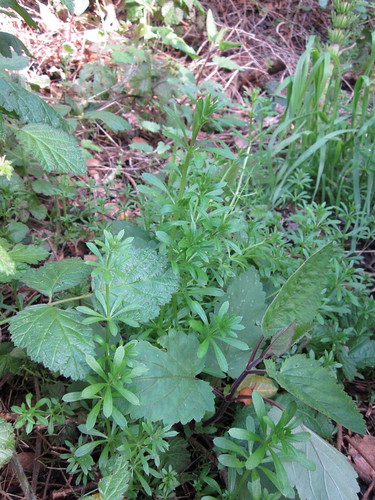 Cleavers are “vegetable velcro.” These plants will stick to your clothes thanks to their little hairy stems and leaves. Still, they’re very tasty either raw or cooked. If you’re going to eat them raw you can crush them up in your hands in order to rid yourself of the velcro-ness (which, as you can imagine, may be unpleasant on your tongue). This plant is used most often in tea form. It is in the same family as coffee and, reputedly, you can use the seeds as a coffee substitute. Kevin says he’s never seen that many seeds in one place though, so its unlikely you’d ever do this.
Cleavers are “vegetable velcro.” These plants will stick to your clothes thanks to their little hairy stems and leaves. Still, they’re very tasty either raw or cooked. If you’re going to eat them raw you can crush them up in your hands in order to rid yourself of the velcro-ness (which, as you can imagine, may be unpleasant on your tongue). This plant is used most often in tea form. It is in the same family as coffee and, reputedly, you can use the seeds as a coffee substitute. Kevin says he’s never seen that many seeds in one place though, so its unlikely you’d ever do this.
Cleaver is also known as “bed straw” because, well, that’s a way people used to use it. Kevin didn’t explain why this particular herb was used for that purpose.
Mugwort
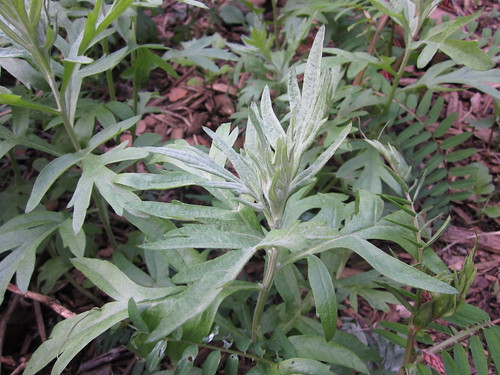 Before there were hops there was mugwort. “Wort” is an old word meaning “herb” and this was the “herb of the mug.” It’s a very aromatic plant and pleasantly so. It has very strong anti-microbial properties and has been used medicinally for thousands of years. While it is edible itself it’s rather strong. Its most common usage is as a tea (though it can also be dried and smoked). Aside from its beer and medicinal properties mugwort also allegedly intensifies your dreams. A tea or tincture of mugwort before bed and your dreams will be vivid, possibly too vivid.
Before there were hops there was mugwort. “Wort” is an old word meaning “herb” and this was the “herb of the mug.” It’s a very aromatic plant and pleasantly so. It has very strong anti-microbial properties and has been used medicinally for thousands of years. While it is edible itself it’s rather strong. Its most common usage is as a tea (though it can also be dried and smoked). Aside from its beer and medicinal properties mugwort also allegedly intensifies your dreams. A tea or tincture of mugwort before bed and your dreams will be vivid, possibly too vivid.
Mallow
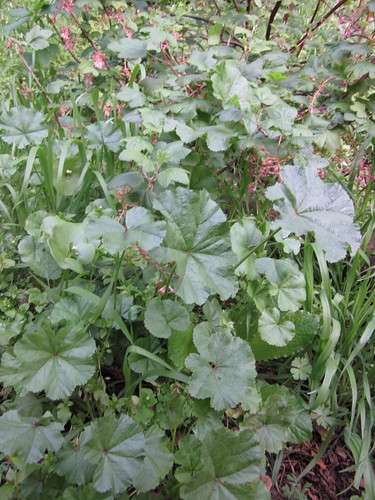 Another weed, another potential meal. This plant grows everywhere around here. It must be fairly hardy as you’ll find it growing through the cracks in the sidewalk. It’s a mucilaginous plant, much like okra. This means when you cook it you may get something slimy. While I like okra I can’t imagine that I’ll enjoy mallow very much. That said, it’s a nutritious plant and can be very useful, particularly if you’re looking to thicken a stew. I’d imagine it may be an adequate substitute if you don’t have any filé gumbo on hand.
Another weed, another potential meal. This plant grows everywhere around here. It must be fairly hardy as you’ll find it growing through the cracks in the sidewalk. It’s a mucilaginous plant, much like okra. This means when you cook it you may get something slimy. While I like okra I can’t imagine that I’ll enjoy mallow very much. That said, it’s a nutritious plant and can be very useful, particularly if you’re looking to thicken a stew. I’d imagine it may be an adequate substitute if you don’t have any filé gumbo on hand.
This is a particularly old plant, being mentioned as far back as Horace and Pliny. It’s still in common usage in many Arab countries.
Stinging Nettle
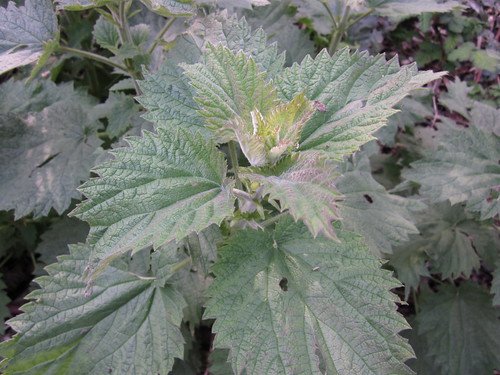 And now we come to our final herb of the day: stinging nettles. This is a powerhouse of the foraging world. It’s one of the most nutritious vegetables that we’ve ever found. It has upward of 20% mineral content, massive amounts of vitamin C and chlorophyl, abundant amino acids, etc.
And now we come to our final herb of the day: stinging nettles. This is a powerhouse of the foraging world. It’s one of the most nutritious vegetables that we’ve ever found. It has upward of 20% mineral content, massive amounts of vitamin C and chlorophyl, abundant amino acids, etc.
These aren’t called stinging nettles just because it sounds cool. No, these things will bite if you don’t know what you’re doing. The stems and leaves are covered with the equivalent of miniscule hypodermic needles full of formic acid. This is the same thing which bee stings contain and it feels about as pleasant. “Uh…why in the hell would you eat bee stings?” you ask? You don’t eat bee stings. That’s because even a small amount of processing renders the “sting” inert. Food processing, cooking, even just rolling it with a rolling pin all make the nettle sting-free.
The nettle is one of those plants which thrive due to foraging. You want to collect the young shoots, before the nettle starts to bolt into flower. Because nettles are a rhizome as you cut from the top it send up more shoots to replace them. You’re happy, the nettle is happy, everyone is happy. Nettles do very well in home gardens but due to the rhizome you should grow them in pots so they don’t spread all over.
Some suggested uses for nettle are in a tea, as a pesto, on a pizza, in a salad (properly processed first)… Pretty much anywhere you’d use spinach and a few other places besides.
And that’s all she wrote. This was an excellent way to spend the afternoon. Now that I’ve written all this up I’m even more pleased I went as it seems that the majority of these plants aren’t even mentioned in any of the books that I listed above.